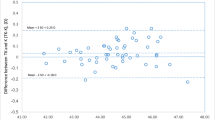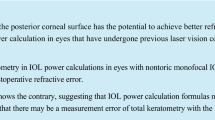Abstract
Purpose
To identify the equivalent K-readings and total keratometry zones that is optimally suitable for calculating the IOL spheroequivalent according to 7 formulas.
Methods
The study included 40 patients (40 eyes) who underwent uneventful femtosecond laser-assisted cataract surgery and refractive lens exchange (RLE) with implantation of a trifocal diffractive IOL (PanOptix, Alcon inc.). Targeted emmetropia was achieved in all patients, no distance and near correction was needed. Retrospective IOL calculations were performed utilizing 7 formulas (SRK/T, Holladay 1 and 2, Haigis, Hoffer Q, Barrett Universal 2, Olsen) and Pentacam keratometry data: Holladay equivalent K-readings, total optical power by ray tracing (TCRP) centered on the apex and pupil in 10 zones (from 0.5 to 5 mm in 0.5 mm increments). For each formula/zone/map combination: postoperative predicted refraction (PPRs), mean absolute errors (MAEs), and median absolute errors (MedAEs) were analyzed.
Results
According to EKR, the Haigis formula showed the lowest error in the central zones up to 3.5 mm, the TCRP zone for Holladay I and II formulas 4.0–4.5 mm, for HofferQ and SRK/T formulas 4.5–5.0 mm, and for Olsen and Barrett II Universal—5 mm.
Conclusion
The use of keratometry data (EKR, TCRP) in the formulas adapted to SimK, with the correct choice of the evaluation zone of keratometric data, will increase the chance of hitting the refractive target.





Similar content being viewed by others
References
Connell BJ, Kane JX (2019) Comparison of the Kane formula with existing formulas for intraocular lens power selection. BMJ Open Ophthalmol 4(1):e000251. https://doi.org/10.1136/bmjophth-2018-000251
Ribeiro F, Ferreira TB (2020) Comparison of clinical outcomes of 3 trifocal IOLs. J Cataract Refract Surg 46(9):1247–1252. https://doi.org/10.1097/j.jcrs.0000000000000212
Alio JL, Plaza-Puche AB, Férnandez-Buenaga R, Pikkel J, Maldonado M (2017) Multifocal intraocular lenses: an overview. Surv Ophthalmol 62(5):611–634. https://doi.org/10.1016/j.survophthal.2017.03.005
Douglas DK, Warren H, Adi A, Li W (2017) Pursuing perfection in intraocular lens calculations: I. Logical approach for classifying IOL calculation formulas. J Cataract Refract Surg 43(6):717–718. https://doi.org/10.1016/j.jcrs.2017.06.006
Norrby S (2008) Sources of error in intraocular lens power calculation. J Cataract Refract Surg 34(3):368–376. https://doi.org/10.1016/j.jcrs.2007.10.031
Savini G, Hoffer KJ, Balducci N, Barboni P, Schiano-Lomoriello D (2020) Comparison of formula accuracy for intraocular lens power calculation based on measurements by a swept-source optical coherence tomography optical biometer. J Cataract Refract Surg 46(1):27–33. https://doi.org/10.1016/j.jcrs.2019.08.044
Saad E, Shammas MC, Shammas HJ (2013) Scheimpflug corneal power measurements for intraocular lens power calculation in cataract surgery. Am J Ophthalmol 156(3):460–467.e2. https://doi.org/10.1016/j.ajo.2013.04.035
Darcy K, Gunn D, Tavassoli S, Sparrow J, Kane JX (2020) Assessment of the accuracy of new and updated intraocular lens power calculation formulas in 10 930 eyes from the UK National Health Service. J Cataract Refract Surg 46(1):2–7. https://doi.org/10.1016/j.jcrs.2019.08.014
Karunaratne N (2013) Comparison of the Pentacam equivalent keratometry reading and IOL Master keratometry measurement in intraocular lens power calculations. Clin Exp Ophthalmol 41(9):825–834. https://doi.org/10.1111/ceo.12124
Shammas HJ, Hoffer KJ, Shammas MC (2009) Scheimpflug photography keratometry readings for routine intraocular lens power calculation. J Cataract Refract Surg 35(2):330–334. https://doi.org/10.1016/j.jcrs.2008.10.041
Savini G, Barboni P, Carbonelli M, Hoffer KJ (2009) Accuracy of Scheimpflug corneal power measurements for intraocular lens power calculation. J Cataract Refract Surg 35(7):1193–1197. https://doi.org/10.1016/j.jcrs.2009.02.031
Potvin R, Gundersen KG, Masket S et al (1995) (2013) Prospective multicenter study of toric IOL outcomes when dual zone automated keratometry is used for astigmatism planning. J Refract Surg Thorofare NJ 29(12):804–809. https://doi.org/10.3928/1081597x-20131115-03
Davison JA, Potvin R (2015) Refractive cylinder outcomes after calculating toric intraocular lens cylinder power using total corneal refractive power. Clin Ophthalmol Auckl NZ 9:1511–1517. https://doi.org/10.2147/OPTH.S88693
Fabian E (1995) Wehner W (2019) Prediction accuracy of total keratometry compared to standard keratometry using different intraocular lens power formulas. J Refract Surg Thorofare NJ 35(6):362–368. https://doi.org/10.3928/1081597X-20190422-02
Savini G, Barboni P, Carbonelli M, Hoffer KJ (2011) Accuracy of a dual Scheimpflug analyzer and a corneal topography system for intraocular lens power calculation in unoperated eyes. J Cataract Refract Surg 37(1):72–76. https://doi.org/10.1016/j.jcrs.2010.08.036
Grein HJ, Schmidt O, Ritsche A (2014) Reproducibility of subjective refraction measurement. Ophthalmol Z Dtsch Ophthalmol Ges 111(11):1057–1064. https://doi.org/10.1007/s00347-014-3064-6
Holladay JT, Wilcox RR, Koch DD, Wang L (2021) Review and recommendations for univariate statistical analysis of spherical equivalent prediction error for IOL power calculations. J Cataract Refract Surg 47(1):65–77. https://doi.org/10.1097/j.jcrs.0000000000000370
Savini G, Hoffer KJ, Lomoriello DS, Ducoli P (2017) Simulated keratometry versus total corneal power by ray tracing: a comparison in prediction accuracy of intraocular lens power. Cornea 36(11):1368–1372. https://doi.org/10.1097/ICO.0000000000001343
Savini G, Barboni P, Carbonelli M, Hoffer KJ (2013) Comparison of methods to measure corneal power for intraocular lens power calculation using a rotating Scheimpflug camera. J Cataract Refract Surg 39(4):598–604. https://doi.org/10.1016/j.jcrs.2012.11.022
Næser K, Savini G, Bregnhøj JF (2016) Corneal powers measured with a rotating Scheimpflug camera. Br J Ophthalmol 100(9):1196–1200. https://doi.org/10.1136/bjophthalmol-2015-307474
Kirgiz A, Atalay K, Kaldirim H, Cabuk KS, Akdemir MO, Taskapili M (2017) Scheimpflug camera combined with placido-disk corneal topography and optical biometry for intraocular lens power calculation. Int Ophthalmol 37(4):781–786. https://doi.org/10.1007/s10792-016-0330-4
Jx K, B C (2020) A comparison of the accuracy of 6 modern toric intraocular lens formulas. Ophthalmology 127(11). https://doi.org/10.1016/j.ophtha.2020.04.039
Author information
Authors and Affiliations
Corresponding author
Ethics declarations
Ethics approval
This article does not contain any studies with animals performed by any of the authors. All procedures performed in studies involving human participants were in accordance with the ethical standards of the local ethics committee of Northwestern State Medical University named after I.I. Mechnikov and with the 1964 Helsinki declaration and its later amendments or comparable ethical standards.
Informed consent
Informed consent was obtained from all individual participants included in the study.
Conflict of interest
The authors declare no competing interests.
Additional information
Publisher’s note
Springer Nature remains neutral with regard to jurisdictional claims in published maps and institutional affiliations.
Supplementary information

ESM 1
Appendix 1. MAEs of predicted postoperative refraction values across ten zones using seven formulas based on EKR 65%, TCRP-apex, and TCRP-pupil mean data without lens constant optimization (PNG 430 kb)

ESM 2
Appendix 2. MedAEs of predicted postoperative refraction values across ten zones using seven formulas based on EKR 65%, TCRP-apex, and TCRP-pupil mean data without lens constant optimization (PNG 387 kb)
ESM 3
(DOC 63 kb)
Rights and permissions
Springer Nature or its licensor (e.g. a society or other partner) holds exclusive rights to this article under a publishing agreement with the author(s) or other rightsholder(s); author self-archiving of the accepted manuscript version of this article is solely governed by the terms of such publishing agreement and applicable law.
About this article
Cite this article
Shukhaev, S.V., Pustozerov, E., Boiko, E.V. et al. The accuracy of the trifocal IOL calculation using equivalent K-readings and total corneal power in different zones. Graefes Arch Clin Exp Ophthalmol 262, 495–504 (2024). https://doi.org/10.1007/s00417-023-06198-8
Received:
Revised:
Accepted:
Published:
Issue Date:
DOI: https://doi.org/10.1007/s00417-023-06198-8




